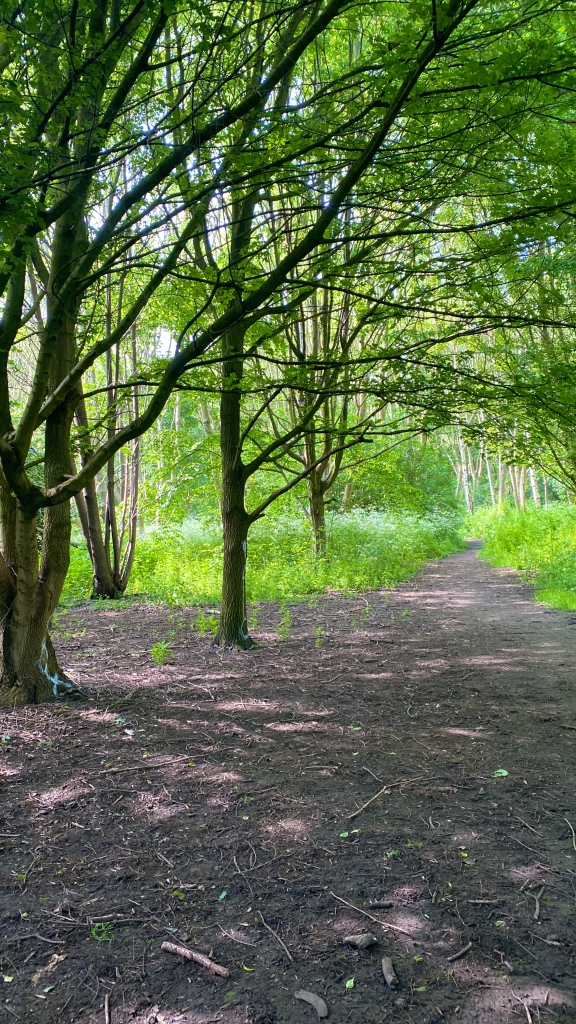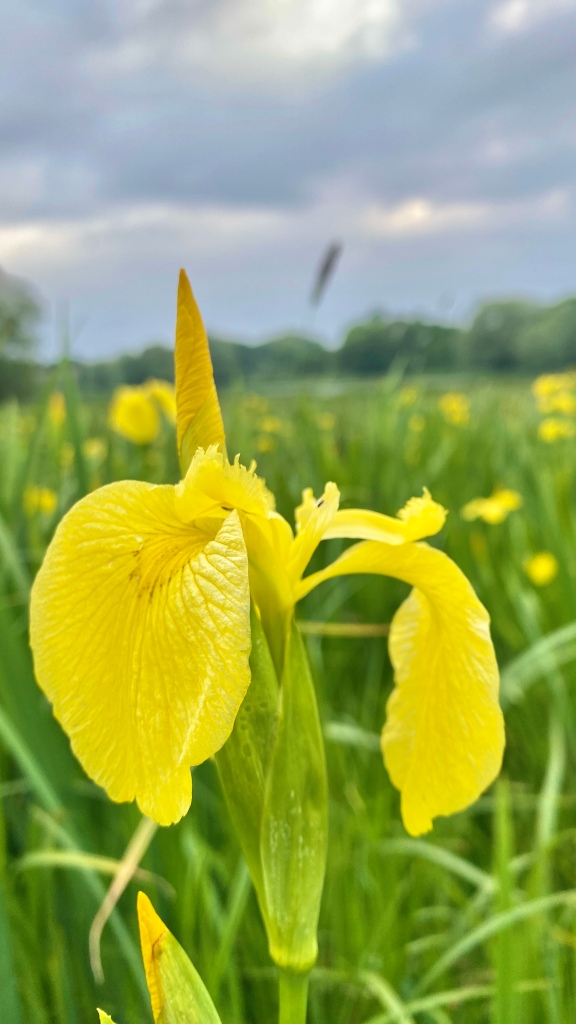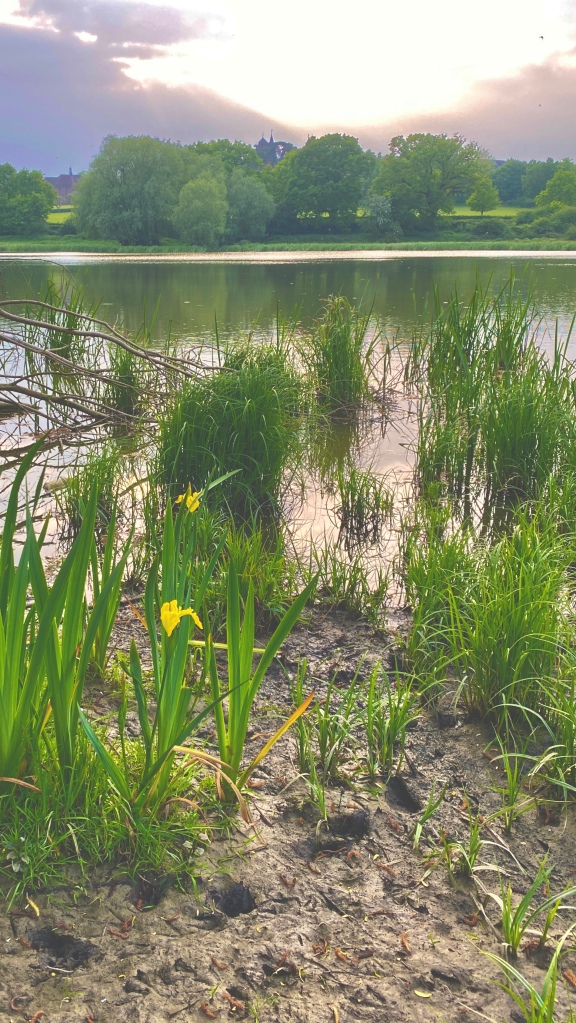20th May 2024
Time codes are in bold | Track titles are in italics
Olympus LS-100, iPhone, drinking glasses, a ceramic bowl of knurlies and washers, modular synth, DAW.
00’00 Skylarks sing, suspended in the air.
There is a mysterious grove of trees sited at the confluence of the three enormous fields where I walk most days. I leave the recorder on the ground at its outermost edge, far away from the path and pointing towards the open fields where the skylarks make their nests and protect their territories. I walk away; my footsteps crunch through dry leaf litter.
00’33 A father and daughter are walking a big golden retriever, who bounds over and snuffles around. Insects buzz. The breeze excites the leaves in the trees overhead.
Old stories imagine the male skylark’s song is bright and strong on the ascent, joyous at the thought of approaching heaven, but at the top he is denied entry by St Peter, falling back down to earth in a quieter, more melancholy key. “He rises and begins to round, He drops the silver chain of sound …” You will not be surprised to learn that skylark numbers have crashed by over half in recent years as a result of intensive farming. Here, in this sparse landscape, it’s a tender joy to be in their company.
03’20 Untitled #007
The existence of the grove of trees has puzzled me for a long while. The land around it has been decimated: turned into two or three giant arable fields that stretch for what feels like a mile in every direction. Why spare these specific trees, when you have destroyed every other living thing?
I’ve been trying to decode the mysteries left behind in the landscape more earnestly over this past month. In doing so, I come across a valuable resource: Oliver Rackham’s ‘The History of the Countryside’. For 98p, I buy a paperback copy published in 1986. Rackham often refers to the incredible level of detail he finds in 19th Century Ordnance Surveys. It turns out that in 2024 there are great many old OS Maps in the collection of The National Library of Scotland, digitised, zoomable, and available for free online.
This is how I discover that the mysterious grove of trees marks the location of a field barn; a structure that has since collapsed or been dismantled. That the footpath I’m walking on was once a substantial farm track, wide enough for a horse and cart, marked with the same importance as the modern road the track eventually joins onto. It has a name. It has a solid line shape on the map. It is there in 1882, in 1902. It is still standing in 1951, along with a glorious patchwork of fields and ancient hedgerows that once supported a delicate, bio-abundant ecosystem. I imagine the eaves of the old barn teeming swallows and martins at this time of year; safely arrived, exhausted after their 6,000 mile migration, gorging on delicious insects, building nests for their chicks, and I feel the ghost of the thing; how its weird empty mark lingers on the landscape long after it has disappeared.
10’22 The skylarks continue their rise and fall cycle; singing their way through 460 syllables. You can hear my footsteps return through the leaves.
10’47 My sister records me a voice note of a saxophonist busking on the corner of Madison Ave and 56th Street in New York. He interrupts his set to ask her a question. After their exchange, he continues playing Dave Brubeck’s Take 5.
11’51 Saturday morning, 10am. I am out walking with an old friend, Flee, in Wick Woods, London E9. We pass an outdoor exercise class in a clearing. Dance music blasts through the air. A helicopter flies overhead. Traffic drones along the nearby A12. I hold my phone out to record, suddenly dazzled with the joy of t-shirt weather, of wandering in and out of pools of dappled shade on the first hot day of spring.


13’44 Untitled Drone. We have reached a point on the River Lee where the path rises up to meet some football pitches.
14’42 A person jogs by.
Flee then takes me on a guided tour of a community tree nursery. The site is tucked away deep in the woods, or at least that’s how it feels to me. I want to be present and soak in the magic so I don’t record anything there. On my return to Suffolk I send her a WhatsApp, “would you be up for sending me a voice note? can you finish the sentence ‘trees are brilliant because??”
15’18 Flee’s voicenote, processed with a bit of distortion and frequency shaping. Untitled Drone continues underneath throughout, rising and falling with the sounds of Wick Woods.
TRANSCRIPT: “Where I am, there’s a kind of, there’s a little woodland that was actually given to the community … which just creates a really nice space to go and hang out … people party in it, forest schools use it, it’s just a really nice place to go and be. It gives you that breath of fresh air. It’s really interesting what’s going on with trees I think at the moment in the urban context, because there is no ‘native’ in London, as it were, because that’s long gone, so everything can be experimental. When it comes to urban tree planting, you’re thinking of cooling the air, of absorbing water, preventing erosion, absorbing groundwater.”
16’09 “Also there’s, you know, there’s a massive social and mental well-being aspect. You wanna create places for people to gather, places of beauty, places just to calm people down. There’s so many studies about how trees can do that. And you know, it’s just such a valuable thing to have around you when you’re feeling a bit miserable and down, it’s just sort of like they’re nice places to be. They give you energy, they calm you, they clean the air, you know, and that’s so important. There’s a lot of edible planting in cities, which is reflective of different communities. There’s lots of different cultures around so if you can sort of interweave that into your planting plan, it’s really nice. It just makes people feel more part of their environment and, gives like a – you know, it’s an education to everyone around you, about different cultures. And you can do that through trees, which is I think really lovely.”
17’16 “The tree planners here are really starting to think about climate change in terms of diversity because now weather conditions are permitting trees that can withstand drought, that can withstand like heavy rainfall because we’re getting these more extreme weather patterns. So it’s really interesting that there’s like, now, in London, a massive diverse sort of range of planting with lots of trees from Japan and China and the Mediterranean. So they’re going to actually withstand the conditions that we have.”
17’43 Textures made with the sounds of clinking little pieces of metal against ceramics and glass.
18’03 “It’s really important to kind of keep our cities cool and, and bring real colour and diversity. Like down my road there’s these amazing Chinese cedar flamingo trees, which in spring have these beautiful pink leaves and they look like flamingos. And they are just, yeah, they just bring so much joy.”
18’31 “Trees. Are. Amazing. Because I think they just bring colour, vibrancy, calmness and just a meeting place. They, you know, they cool the air, they take out pollution and they just … make you happy!”
19’40 The early part of a dusk chorus from my bedroom window back in Suffolk. The calls of a blackbird and a song thrush ring out. You can hear the sharp bark of a muntjac over and over in the distance.
Untitled Drone continues underneath. I had another sleepless night this week. This month’s mix has been constructed with intentionally soporific vibes: it would be nice to be able to put myself to sleep listening to it later.
23’13 A different evening chorus from the window, this time in the rain. Droplets ping off the rooflight, slap into the tiles, spatter off leaves. Cars swoosh through pools of water that collect in the road, I imagine highpass filters sweeping through two tons of white noise. I add a little reverb later to highlight this sensation.
27’42 Untitled #008. Clip posted to Xitter on 15th May. I keep nearly leaving the platform, but now and then a post will really fly and a lot of new people will get introduced to what I do.
29’28 I walk down to the mere in town one evening and am rewarded with mud and marsh and swathes of yellow flag iris in flower as far as the eye can see.


The terrain starts to change on the walk back up: the thud of boots on compacted earth eventually morphing into the dry crunch of gravel. These sounds are being processed through Valhalla Supermassive and ShaperBox.
31’41 I have to cross a bridge to leave the marsh and return to higher ground. There is a walkway and a bridge to cross; a gate with a latch and a tightly coiled spring which lets out a mighty groan when it is opened and closed. It has a fantastic texture when sent through a delay effect.
I try not to get excited and bang on about discrete sounds like this because I find the whole idea of getting excited and banging on about sounds boring on principle.
There is a scene in the film Shiva Baby – a black comedy of errors set in the tangled web of a Jewish family gathering – where the protagonist’s father says to her, somewhat kindly, “Look sweetheart, feminism isn’t exactly what I would call a career” and the protagonist shoots back, before her father can finish, “Feminism isn’t my career! It’s a lens!!” I did feel something click when I heard that line, because I think that’s exactly how I feel about sound. Sound is a lens; a way of seeing; an angle; a stick with which to poke around in stuff.
Except, as here, in the case of this processed coiled spring, or when I hear the squelch of a TB-303, or the sound of boots on dry leaves, then maybe it does become the object, and I never want it to stop?
32’41 The journey on foot continues. A day later I set up some glasses and record myself clinking them with a metal straw, layering and transposing and adding delay to add an extra layer of texture here. An untuned oscillator runs through a filter, pinged by an envelope and into a delay. Sound may be a lens, but this is a performance.
35’39 Honeysuckle from the album Florescence, 2022.
The honeysuckle that engulfs the damson tree at the back of the garden has come into full bloom. But, being a shade-lover, the climber has wrapped itself around its host in such a way that I am only able to catch a glimpse of its glory: a purple-pink profusion of stars peeling back to reveal long tongues of white-gold. My lucky neighbours to the north get the full display.
42’40 I am in the kitchen making a jug of water infused with fresh mint from the garden. I pour some into a glass and add ice cubes from the freezer. The writer Natalie Olah is discussing her new book on taste, class and the politics of ugliness in a podcast playing in the background. I think about how bougie my drink choice will sound when I go to type it out. Olah mentions the dearth of people from working class backgrounds with careers in the arts. I daydream about the things that could actually make an impact to these numbers in Britain (widely available and genuinely affordable housing; a universal basic income; free higher education for all; turning Eton into a safari park).
45’40 I am crunching ice between my teeth.
45’48 The pipe at the end of the field. It’s lighter and higher in register than in last month’s mixtape, which makes sense for the amount of rainfall we’ve had. I’m hunkered down as close to the edge of the ditch as I can get without toppling over into its depths. My arm is outstretched towards the flow, my phone catches the sound of the water as it trickles into the tiny brook.
47’30 The close of the dusk chorus from my bedroom window. As it gets dark, the birds stop singing one by one. Eventually they all fall silent. This is that moment, accompanied by the sinuous sound of a motorbike engine, carving its way around the multitude of bends and corners, marking out ancient boundaries that relate to nothing much any longer, the traveller making their way audibly for miles across this vast flat landscape.
49’30 Untitled #009, a close cousin of Untitled #007 and Untitled #008.
The lower sustained drone notes are being played on a harmonic oscillator. The higher set of notes is being sounded out simultaneously by a sinewave oscillator being fed through a SEM filter, and a second oscillator having its pulsewidth modulated by control voltage. All the waves are being squished around by hand with an envelope generator before going through a delay.
55’40 Fin
Stray Links
Ordnance Survey Maps ’25 inch’ England and Wales, 1841-1952. The most detailed topographic mapping covering most parts of England and Wales from the 1840s to the 1950s.
George Meredith, The Lark Ascending poem in full as a .pdf
Ten Thousands Posts podcast hosted by Phoebe Roy and Hussein Kesvani. Bad Taste Featuring Natalie Olah.